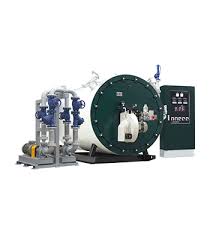
Sen . 21, 2024 19:17 Back to list
steam pressure in boiler
Understanding Steam Pressure in Boilers
Boilers play a crucial role in various industrial applications, where steam generation is vital for processes such as power generation, heating, and manufacturing. One of the most critical parameters that influence boiler performance and efficiency is steam pressure. Understanding steam pressure in boilers is essential for optimizing operations, ensuring safety, and enhancing overall system efficiency.
Steam pressure refers to the force exerted by steam within a boiler system. This pressure is a result of the thermal energy produced when water is heated, causing it to transform into steam. The efficiency of a boiler is largely determined by the steam pressure it can maintain, as it impacts the energy conversion process and the operational capacity of the system.
The Importance of Steam Pressure
High steam pressure often indicates that a boiler is operating effectively, producing a higher energy output. However, it is crucial to strike a balance; excessive steam pressure can lead to potential hazards such as boiler explosions or system failures. Therefore, maintaining the right steam pressure is vital for safe and efficient boiler operation.
In industrial settings, the required steam pressure can vary significantly based on the application. For instance, power generation facilities typically operate at higher pressures to maximize energy production. In contrast, lower pressures may be sufficient for heating applications or in smaller boilers.
Factors Influencing Steam Pressure
Several factors affect the steam pressure within a boiler system
steam pressure in boiler

1. Temperature As the temperature of the water increases, so does the steam pressure. This relationship is governed by the principles of thermodynamics. Higher temperatures lead to increased kinetic activity among water molecules, resulting in higher pressure as steam forms.
2. Fuel Type Different fuels used in boilers can affect combustion efficiency, which in turn impacts steam pressure. Fuels with higher calorific values generally produce more heat, raising the steam pressure faster.
3. Boiler Design The design and construction of a boiler also play a significant role in how steam pressure is generated and maintained. Modern boilers are designed to withstand high pressures and optimize heat transfer, leading to more stable steam production.
4. Water Quality The quality of water used in the boiler is critical. Impurities or excessive mineral content can lead to scaling, which affects heat transfer and ultimately steam pressure. Regular water treatment is necessary to maintain optimal boiler performance.
Monitoring and Control
Monitoring steam pressure is vital for safety and efficiency. Boilers are equipped with pressure gauges and control systems that ensure operators can maintain the desired pressure levels. Regular maintenance and inspections are essential to identify any issues that may affect steam pressure, such as leaks or component failures.
Conclusion
In summary, steam pressure is a fundamental aspect of boiler operation, influencing efficiency, safety, and overall performance. A thorough understanding of the factors affecting steam pressure and the ability to monitor and manage it effectively is essential for anyone working in industries relying on boiler systems. By maintaining appropriate steam pressure levels, businesses can optimize energy production, ensure safety, and enhance operational efficiency, ultimately leading to improved productivity and reduced costs.
-
Oil Fired Hot Water Boilers Sale - High Efficiency & Affordable
NewsJul.31,2025
-
High-Efficiency Commercial Oil Fired Steam Boiler for Industry
NewsJul.30,2025
-
High-Efficiency Biomass Fired Thermal Oil Boiler Solutions
NewsJul.30,2025
-
High Efficiency Gas Fired Thermal Oil Boiler for Industrial Heating
NewsJul.29,2025
-
High-Efficiency Gas Fired Hot Water Boiler for Sale – Reliable & Affordable
NewsJul.29,2025
-
High Efficiency Biomass Fired Hot Water Boiler for Industrial and Commercial Use
NewsJul.29,2025
Related PRODUCTS






















